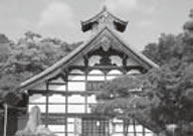 「寺社を歩けば京都がわかる」 より無料公開中!
「寺社を歩けば京都がわかる」 より無料公開中!
精選した京都の50余の寺社について、その歴史、建物の特徴、建立の由来などを日英対訳で紹介するガイドブック「寺社を歩けば京都がわかる」より、「龍安寺」「石清水八幡宮」「天龍寺」を無料公開中です。
The Zen temple founded by the famous priest Musõ Soseki
 Address: 68 Saga Tenryu-ji Susukinobaba-chõ,
Address: 68 Saga Tenryu-ji Susukinobaba-chõ,
Ukyõ-ku, Kyoto-shi
Tel: 075(881)1235
Hours: 8:30AM–5:30PM
(October 21–March 20: 8:30AM–5:00PM)
Admission: Gardens only: ¥500 (Gardens and buildings: ¥600)
2 min walk from Keifuku Arashiyama Line Arashiyama Sta.
A tour of the temples and shrines around Sagano begins from Tenryu-ji. When you alight from the Keifuku Arashiyama line at the last station, Arashiyama, the grounds of Tenryu-ji lie right in front of you.
At the time Tenryu-ji was built, it boasted extensive temple grounds from what today is Seiryõ-ji to Arashiyama. Aside from Nanzenji, it ranks as the highest of Kyoto’s five great Zen temples. This is largely due to the support of the Muromachi Bakufu, beginning with Ashikaga Takauji, who swore to protect Tenryu-ji for the sake of the holy teachings of Musõ Soseki.
In his portraits, Soseki (1275–1351), the founder of Tenryu-ji, has a gentle face and sloping shoulders, but his amazing exploits and political acumen belied his weak appearance.
When Emperor Godaigo, who had formed the Southern Court, died in 1339, Soseki urged Ashikaga Takauji and his brother Tadayoshi, who had opposed the emperor, to built a temple to honor him. Takauji had once been loyal to the emperor and felt some personal responsibility for what had befallen him, so he donated a manor and supported the construction of a temple. However, there were not enough funds to complete the construction, so Soseki, with the help of Tadayoshi, organized ships to trade with China, the Tenryu-ji ship, in order to support the project.
The ship set sail in the autumn of 1342, and Soseki contracted with a Hakata, Kyushu, merchant to operate the ship, obtaining a promise for a set amount of bullion regardless of the profit the ship made. This allowed construction of the temple to go forward, and in August 1345, on the seventh anniversary of Godaigo’s death, a ceremony was held to mark the opening of the temple. For a single Zen priest to establish a temple venerating the emperor, and to gather funds for it by conducting trade with China, was a remarkable exploit.
Sadly, in its more than 660 years of history, the grand buildings of Tenryu-ji have been burned down eight times. The first fire was in 1358, and the second head priest, Shun’oku Myõha, rebuilt three more times by 1380. The fifth fire was said to be arson, and in addition to the buildings, all of the temple's carefully collected texts were destroyed. Fire struck again during the Õnin War and again in the Edo period, in 1815, and once again in 1864 during the Hamaguri Gomon Rebellion, when rebel samurai from Chõshu (Yamaguchi) challenged the troops of the Bakufu. The buildings that we see today were all constructed since the Meiji era.
When entering the grounds of Tenryu-ji along the approach, the hõjõ pond and a broad expanse of woods are in the center, with sub-temples with tiled roofs joined by earthen walls to left and right, and the hattõ just in front. The hattõ is not normally open to the public, but inside are wooden statues of the Buddha, Soseki, and Ashikaga Takauji. “Unryuzu,” the dragon painting on the ceiling, was done by Kayama Matazõ recently.
From the entrance reception in the kuri, enter the dai-hõjõ to see the seated wooden statue of the Buddha (shaka nyorai). The eastern garden is a peaceful space spread with white sand, and the western garden centers on Sõgen pond. You can exit the shoin (study-cum-living room) and use the walkway to examine the Tahõ-den, completed in 1934 to honor Emperor Godaigo. Return to the kuri to enter the famous stroll pond Tenryu-ji garden. The garden, with Sõgen pond at its center, makes use of the surrounding landscape in the form of Mt. Kameyama and Mt. Arashiyama in its design. The trees that circle the pond are a clear green in spring and a gorgeous yellow in the fall.
In addition to the gardens here, Soseki also designed gardens at Tõji-in, Saihõ-ji (Koke-dera), and other temples.
Leaving through the north gate and turning to the right, you will see the Nonomiya-jinja with its famous black-wood torii gate, and then we come at last to the high point of a stroll through Sagano.